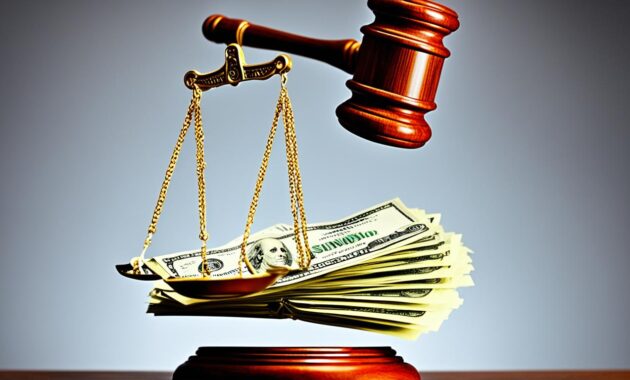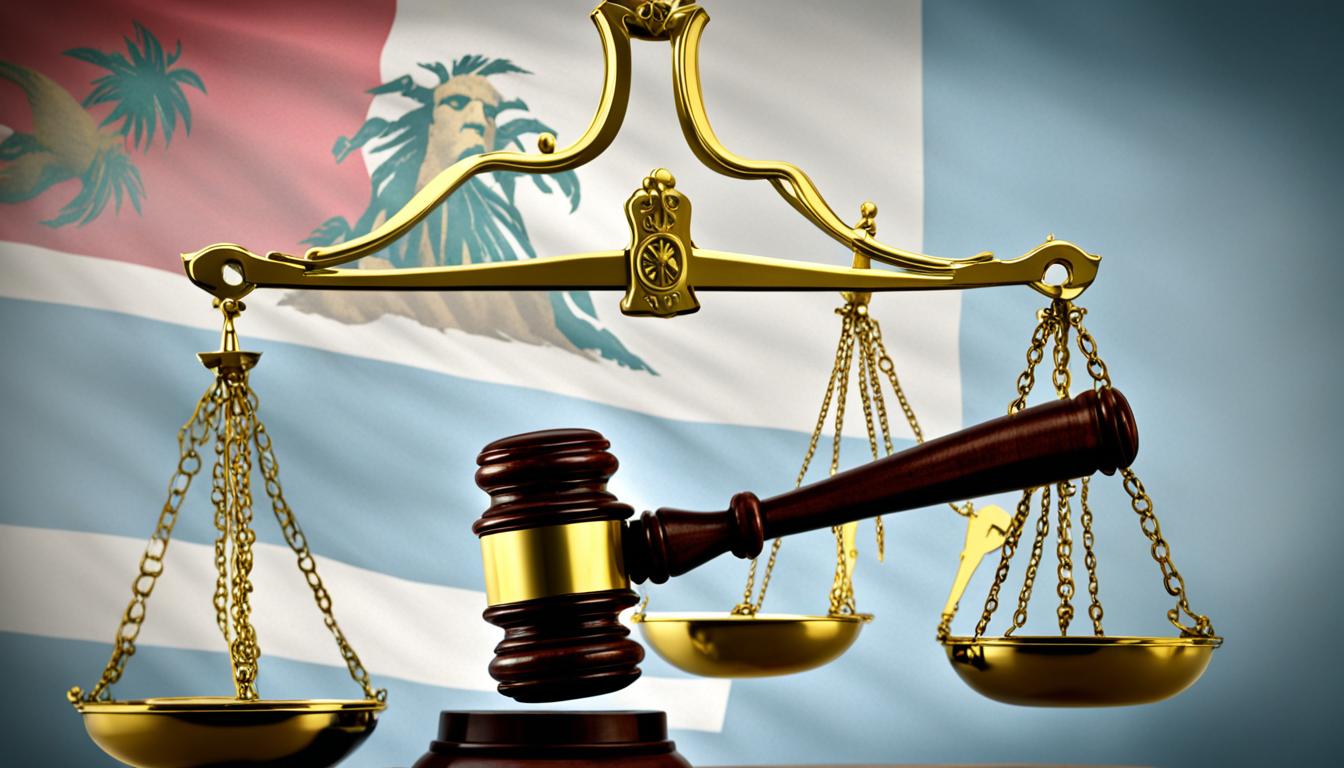Legal expert William Bateman wrote this guide. It’s published by LexisNexis. It covers California Criminal Law from start to finish.
This guide is perfect for both prosecutors and criminal defense attorneys. It has checklists, case references, and tips for the complex criminal justice system in California.
It covers everything from starting a trial to plea bargaining. You’ll learn about handling different crimes, like felonies and misdemeanors.
The guide talks about jury trials, sentencing, and what happens after a conviction. It also covers the roles of prosecutors and defense counsel. It explains the California Victims’ Bill of Rights and how to move through the courts.
This guide is easy to read and full of practical advice. It uses checklists and real cases to help you understand California Criminal Law. It’s a must-have for criminal lawyers and legal experts.
Fundamental Duties of Prosecutors and Defense Attorneys
In California’s criminal law, the roles of prosecutors and defense attorneys are key. Prosecutors work for the state to protect everyone and follow the law. They make sure the legal process is fair. Defense attorneys fight for their clients, protect their rights, and help them in court.
Duty of Prosecutor
Prosecutors follow strict rules, like Rule 5-110 of the California Rules of Professional Conduct. This rule was set by the Supreme Court in 2017. It tells prosecutors to stop people under them from saying things that could harm the case.
Prosecutors must share any new evidence that could prove a defendant is innocent. If they find strong evidence that shows a defendant was wrongly convicted, they must fix it.
Duty of Defense Counsel
A defense attorney’s main job is to protect their client and make sure they get a fair trial. They investigate the case, question witnesses, and challenge the prosecution’s evidence. They also help their clients make choices, like whether to plead guilty or go to trial.
Defense attorneys are key to keeping the criminal justice system fair. They make sure the accused’s rights are respected and the system stays honest.
| Prosecutor’s Duties | Defense Counsel’s Duties |
|---|---|
| Protect the public, uphold the law, and ensure a fair judicial process | Zealously defend clients, safeguard their rights, and provide effective legal representation |
| Comply with ethical standards, including disclosure of exculpatory evidence | Advise clients on legal options, including plea bargaining |
| Supervise subordinate lawyers and non-lawyer employees to ensure compliance with professional standards | Uphold the ethical standards of the legal profession and maintain the integrity of the criminal justice system |
Prosecutors and defense attorneys in California are crucial for a fair justice system. They follow their ethical duties to protect everyone’s rights and serve justice.
Criminal Investigation Procedures
In California, criminal investigations are key to justice. Law agencies collect evidence, talk to witnesses, and follow rules to build a strong case. This helps prosecutors figure out the right charges, like penal code violations or felonies.
Getting search warrants is a big part of these investigations. Officers need a good reason to show a judge to get a warrant. They also have to follow rules when detaining and arresting people to protect everyone’s rights.
- Prosecutors and defense lawyers need to know a lot about criminal investigations to handle their cases well.
- What evidence is allowed in court is very important for a case’s strength.
- Suspects have rights, like the right to stay silent and get a lawyer, during the investigation.
Knowing how criminal investigations work in California helps lawyers help their clients better. They need to pay attention to details and follow the law for fair results in criminal cases.
“The success of a criminal investigation often hinges on the diligence and precision with which it is conducted.”
Bail Determination and Pretrial Resolutions
The bail amount in California depends on the crime and how likely the defendant is to run away. Good lawyers can sometimes get bail lowered by arguing to the court. Also, many cases are settled before trial through negotiations, showing how important good bargaining is.
Evidentiary Motions and Officer Accountability
Defense lawyers might ask to throw out evidence that was wrongly taken. This makes sure only legal evidence is used at trial. Pitchess motions let them look into police officers’ records, which could show bias or wrongdoings that affect the case.
Initiation of Formal Criminal Proceedings
In California, starting criminal proceedings is a key step in the legal process. It begins with filing an accusatory pleading, like an indictment or an information. Then, both sides get to look at and share evidence.
The Accusatory Pleading
The accusatory pleading charges the defendant with criminal proceedings, penal code violations, felony charges, or misdemeanor offenses. It must follow legal rules to make sure the charges are clear and the defendant’s rights are protected.
Discovery Process
Discovery is key in criminal proceedings. It lets both sides look at and share evidence. This makes sure the trial is fair and open, helping the defense and prosecution prepare well.
In California, misdemeanor cases usually go to trial in 30 to 45 days after arraignment. Felony cases take about 60 days. But, defendants can choose to delay their trial for more time to gather evidence and prepare.
Starting criminal proceedings in California is complex and needs legal experts. The Carlos Navarrete Law Firm has over 23 years of experience in criminal cases. They work hard to protect their clients’ rights at every step of the legal process.
“The initiation of formal criminal proceedings is a critical juncture in the California legal system, where the rights of the accused are paramount and the burden of proof lies with the prosecution.” – Carlos Navarrete, Criminal Defense Attorney
Preliminary Examinations in California Criminal Law
The preliminary examination is a key step in California’s criminal process. It happens within 10 days of the first court hearing. The judge checks if there’s enough evidence to believe the defendant did the crime.
This hearing looks at probable cause for the charges of penal code violations, felony charges, or misdemeanor offenses.
Prosecutors must show there’s enough evidence to believe the crime happened and the defendant was involved. They use things like witness stories, physical evidence, and police reports to prove this.
Evidentiary Considerations
This process helps get rid of cases with weak evidence. If the evidence is not strong enough, the judge might drop the charges. Or, they might add more charges if the evidence shows the defendant did more than what was first thought.
The result of the preliminary hearing is very important. A successful defense can get the case thrown out. But, if the prosecution wins, the case goes to trial in a higher court. This makes the preliminary hearing a crucial step in the criminal justice system.
“The preliminary hearing process serves as a significant checkpoint for the prosecution as it determines whether there is probable cause to proceed with criminal charges.”
Information and Motion to Set Aside Information
In the world of criminal proceedings, filing an information and moving to set it aside is key. An information is a formal accusation filed by the prosecution after a preliminary hearing. It lists the penal code violations, felony charges, and misdemeanor offenses against the defendant.
The defense can then ask to set aside the information. This is called a Penal Code 995 motion. It lets the defense question the evidence from the preliminary hearing. If the evidence is weak, the information might be set aside. This could lead to dropping some or all charges.
- Grounds for a successful Penal Code 995 motion include lack of probable cause, illegal evidence, and not giving evidence on time.
- The prosecutor must file the information within 15 days after the preliminary hearing, or the case might be dismissed.
- If the preliminary hearing goes on for too long without the defendant being released, it could be seen as illegal. This could help the defense.
Knowing how to file an information and move to set it aside is key for both sides in California criminal law. It helps ensure everyone’s rights are protected in these criminal proceedings.
| Statistic | Value |
|---|---|
| Percentage of Penal Code 995 motions leading to dismissal | Varies based on the specific grounds, but can be a significant factor in resolving felony charges or misdemeanor offenses |
| Timeframe for prosecutor to file information after preliminary hearing | 15 days |
| Maximum timeframe for preliminary hearing to extend without defendant’s release | Varies, but an unlawful commitment may be grounds for a successful 995 motion |
“Understanding the filing of an information and the motion to set it aside is essential for navigating the complexities of California criminal law.”
Common Pretrial Motions in California Criminal Cases
In California, defendants often file pretrial motions to protect their rights and boost their defense. A key motion is the motion to suppress evidence. This lets defendants question the legality of evidence found by police. This could weaken the case against them.
Motion to Suppress Evidence
The motion to suppress evidence is based on the Fourth Amendment’s protection against illegal searches and seizures. It’s a strong tool for defendants. They argue that evidence was found illegally or without a good reason. This could stop the prosecution from using that evidence at trial.
This can greatly affect the outcome of criminal proceedings. It’s especially important in cases of penal code violations, felony charges, misdemeanor offenses, or DUI laws.
| Common Pretrial Motions in California | Key Considerations |
|---|---|
| Motion to Dismiss (Penal Code 995 PC) | Seek dismissal of charges due to legal defects or lack of probable cause |
| Motion to Suppress Evidence (Penal Code 1538.5 PC) | Challenge the legality of evidence obtained by law enforcement |
| Pitchess Motion | Access a police officer’s personnel file for potential bias or misconduct |
| Serna Motion | Address unreasonable delays in the prosecution of the case |
| Brady Motion | Compel the prosecution to disclose exculpatory evidence |
Other motions in California criminal cases include asking to lower bail, withdraw a plea, or change the trial location. It’s important for defendants and their lawyers to think about these motions carefully. They need to make sure they’re helping their clients the most.

“The pretrial process in California can last anywhere from days to over a year, depending on the charges and willingness to settle.”
Subpoenas in Criminal Proceedings
In California’s criminal justice system, subpoenas are key in the investigation and trial stages. They force witnesses to come or produce important evidence like documents and items.
A subpoena duces tecum is a special subpoena. It makes the person with business records give out documents or evidence. This helps both sides build their cases, as the California Penal Code says.
If someone ignores a subpoena, they could face serious trouble. This includes getting arrested and being charged with contempt of court. It’s important to know the rules for serving and answering subpoenas. Getting legal advice is a good idea to follow the law.
| Subpoena Type | Purpose | Consequences of Non-Compliance |
|---|---|---|
| Subpoena ad testificandum | Compels a witness to appear in court and provide testimony | Arrest warrant, contempt of court (up to 6 months in jail and/or $1,000 fine) |
| Subpoena duces tecum | Requires the production of documents, records, or other physical evidence | Arrest warrant, contempt of court (up to 6 months in jail and/or $1,000 fine) |
Knowing how to handle subpoenas is key for lawyers. Using them well can make or break a case. It’s vital for lawyers to keep up with the law and best practices.
“The quality of an attorney can significantly impact subpoenaing and handling witnesses during a criminal proceeding, ensuring efficiency and success in legal matters.”
california Criminal Law: Plea Bargaining Process
In California, plea bargaining is key in solving criminal cases quickly. It lets defendants talk with prosecutors to get less severe charges or sentences. This process includes charge and sentence bargaining, leading to guilty pleas and Alford pleas.
But not all crimes can be bargained in California. Serious crimes like murder or sexual assault usually don’t fit. The state makes sure plea deals are fair and voluntary. For a deal to be valid, there must be clear explanations and legal help.
California’s laws on plea bargaining are more flexible than federal ones. This lets both sides agree on terms that work for them. Recent changes have made people think again about plea bargaining, showing how important a good lawyer is in the criminal justice system.
Plea bargaining is very common in California, with over 90% of criminal cases ending this way. Less than 10% of cases go to trial. This shows how big a role plea bargaining plays in dealing with penal code violations, felony charges, and misdemeanor offenses.
| Plea Bargaining Statistics in California | Percentage |
|---|---|
| Criminal Convictions Resulting from Plea Bargains | Over 90% |
| Criminal Cases Proceeding to Trial | Less than 10% |
California tried to stop plea bargaining for serious crimes in 1982. But, it made exceptions for cases where evidence is lacking, getting a key witness is hard, or reducing the charge won’t change the sentence much.
Plea bargaining can happen at different times, from before charges to after an appeal. Every deal must get a judge’s okay to be final. This makes sure the plea bargaining process is fair.

“Plea bargaining is a crucial component of California’s criminal justice system, offering defendants the opportunity to mitigate the consequences of their actions through negotiation and compromise.”
Jury Trial Procedures and Tactics
In California, the jury trial is key in deciding the outcome for those facing criminal proceedings, penal code violations, felony charges, or misdemeanor offenses. The first step is picking the jury. The judge, lawyers for both sides ask potential jurors about their views and life to find any bias.
Jury Selection
Some potential jurors can be removed by the judge or lawyers using “peremptory challenges” or “challenges for cause”. The aim is to create a fair jury that can look at the evidence and make a just decision.
Motions and Closing Arguments
Witnesses are very important in a California criminal trial. Both sides call witnesses to back their case. The process includes direct questioning, cross-questioning, and sometimes re-direct questioning.
At the end of the trial, both sides give final arguments to sum up their case and evidence. If the jury can’t agree, they might have another trial with a new jury.
| Key Aspects of California Criminal Jury Trials | Details |
|---|---|
| Jury Composition | A California criminal trial has a jury of 12 community members who decide if the defendant is guilty. |
| Jury Selection | Lawyers can use up to 20 peremptory challenges to pick or remove potential jurors. |
| Opening Statements | The prosecution speaks first in opening statements, then the defense. |
| Witness Testimony | Experts can give their opinions during the trial. |
| Closing Arguments | The prosecution speaks first in closing arguments, followed by the defense, and then the prosecution again for a final say. |
| Jury Deliberations | The jury must all agree that the defendant is guilty beyond a doubt to convict. |
The details of jury trials in California need careful planning and smart moves from both sides. Knowing how to pick a jury, make motions, and give closing arguments can really affect the result of a criminal proceeding.
“The jury trial is the cornerstone of our criminal justice system, where the fate of the accused is decided by their peers.”
Judgment, Sentencing, and Post-Conviction Matters
This guide covers the key stages of judgment, sentencing, and what happens after in California criminal law. It talks about the time needed, the pre-sentence report, and the arraignment. It also looks at sentencing goals and what affects probation.
It explains imprisonment, enhancements, and credits for good behavior. The guide also looks at hearings for probation violations and restitution. It talks about appeals for both sides.
In California, those convicted can ask for relief after the fact. They can seek to reverse a conviction, get out of prison, or get a lighter sentence. There are many ways to get relief, like appeals, writs, commutation, and petitions.
For misdemeanors, appeals must be filed in 30 days in the Appellate Division of the Superior Court. Felony appeals go to the California Court of Appeal within 60 days. Federal cases go to the U.S. Court of Appeal for the Ninth Circuit and can go to the Supreme Court after that.
The process of seeking relief after conviction includes getting court records, checking if you’re eligible, and preparing motions. You then file the motions, go through litigation, and get the court to change the outcome if needed.

